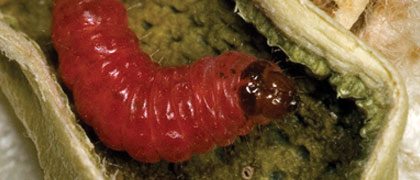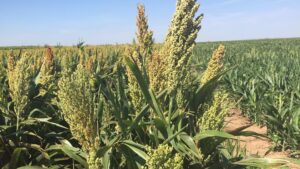Bt Questions Answered
As Monsanto continues its research, study sheds new light on pest resistance to Bt crops.
|
Bruce Tabashnik of the University of Arizona holds a petri dish containing pink bollworm caterpillars. |
“When Bt crops were first introduced, the main question was how quickly would pests adapt and evolve resistance,” says Bruce Tabashnik, head of the UA department of entomology, on the university’s website. “And no one really knew; we were just guessing. Now, with one billion acres of these crops planted over the past 16 years, and with the data accumulated over that period, we have a better scientific understanding of how fast the insects evolve resistance and why.”
The study, titled Insect Resistance to Bt Crops: Lessons From the First Billion Acres, analyzed data from 77 studies of 13 pest species in eight countries on five continents. “The researchers found well-documented cases of field-evolved resistance to Bt crops in five major pests as of 2010, compared with only one such case in 2005,” the university website says. “Three of the five cases are in the United States, where farmers have planted about half of the world’s Bt crop acreage.”
The study’s authors say the findings are actually not a surprise, and are in line with what they expected based on evolutionary theory, according to study co-author Yves Carriere. “Conditions are most favorable if resistance genes are initially rare in pest populations; inheritance of resistance is recessive—meaning insects survive on Bt plants only if they have two copies of a resistance gene, one from each parent—and abundant refuges are present.” Refuges consist of standard, non-Bt plants that pests can eat without ingesting Bt toxins, the UA notes.
Although continued high insect pressure in 2013 has challenged Monsanto to come up with ways to ensure success among growers who use Bt products, Monsanto corn traits manager Luke Samuel says this year was much different compared to 2012.
“The (two years) were really polar opposites. 2012 had a very early spring, so we had insect pressure early and across a broad geography. 2013 offered a different wrinkle—it was cool and wet and much of that insect pressure came about later in the season,” says Samuel.
Illinois, Iowa and Nebraska continued to experience high corn rootworm pressure in 2013, he adds. “I think the biggest [factor] each year is weather. Certainly Mother Nature throws us curve balls each and every year in agriculture, and looking at southern Minnesota and northern Iowa, we didn’t see as much pressure in those areas, simply because of the harder winter we had last year. Certainly across the key areas, corn rootworm was certainly a significant pest again [in 2013].”
The bollworm (Helicoverpa zea) is a major pest of cotton, corn and other crops that has evolved resistance to Bt cotton in the southeastern United States.
One of the UA study’s main conclusions is that the risk of resistance can be gauged before a Bt crop is commercialized. To do so, two main factors must be looked at—whether or not the pest’s genetic resistance is recessive, and how widespread the resistance being seen in the specific crop actually is. If the pest’s resistance is in fact recessive, and initial resistance rare, the risk of rapid resistance evolution is low, the UA says. In that case, setting aside a small portion of refuge land can significantly delay pest resistance to a Bt crop.
The finding that refuges are the key to slowing down pest resistance is an important one. The value of refuges has been disputed in recent years, but Tabashnik says the study shows how valuable they really are. Researchers used the pink bollworm as an example. In the U.S., scientists, industry and government collaborated to ensure growers implemented an appropriate refuge strategy for their Bt crops. Pink bollworms did not rapidly develop Bt resistance there. In India, though, where refuges were not widely and consistently used, the cotton pest developed resistance quickly.
In the worst cases of general Bt resistance the study authors saw, resistance developed in as little as two years. In the best cases, it took as long as 15 years.
“We certainly know that Bt and other traits provide value to growers and allows them to really mitigate a lot of those risks that affect farming every year, one of them being pests such as corn rootworm. As we look at what our plans for the future are, really it’s about making those [products] durable and available for future generations as well, as well as protecting the new technology,” says Samuel. “Refuge is a key factor in that. …It is a key thing we’re doing in all the traits we’re putting out into the marketplace, and we’re continuing to monitor how effective they are and how they’re working out there as well.”
Tabashnik says he doesn’t think pest resistance to crops is something that can ever be totally prevented, he tells the UA. “These plants have been remarkably useful and in most cases, resistance has evolved slower than expected. …You’re always expecting the pest to adapt. It’s almost a given that preventing the evolution of resistance is not possible.”
For Monsanto, that means continuing to develop its next generation of traits, says Samuel. “Specific to corn rootworm, we’re looking ahead to our third generation technology to be launched later in the decade. Certainly, that’s going to be a very important factor for both durability of the trait long-term, and looking at the refuge scenario again, that’s going to be in a refuge-in-a-bag configuration. We continue to focus on research and development of new and better traits to continue to help farmers be productive out there.”
Marc Zienkiewicz
 |
The full UA’s study is published in the journal Nature Biotechnology and can be purchased at www.nature.com/nbt/journal/v31/n6/full/nbt.2597.html |














